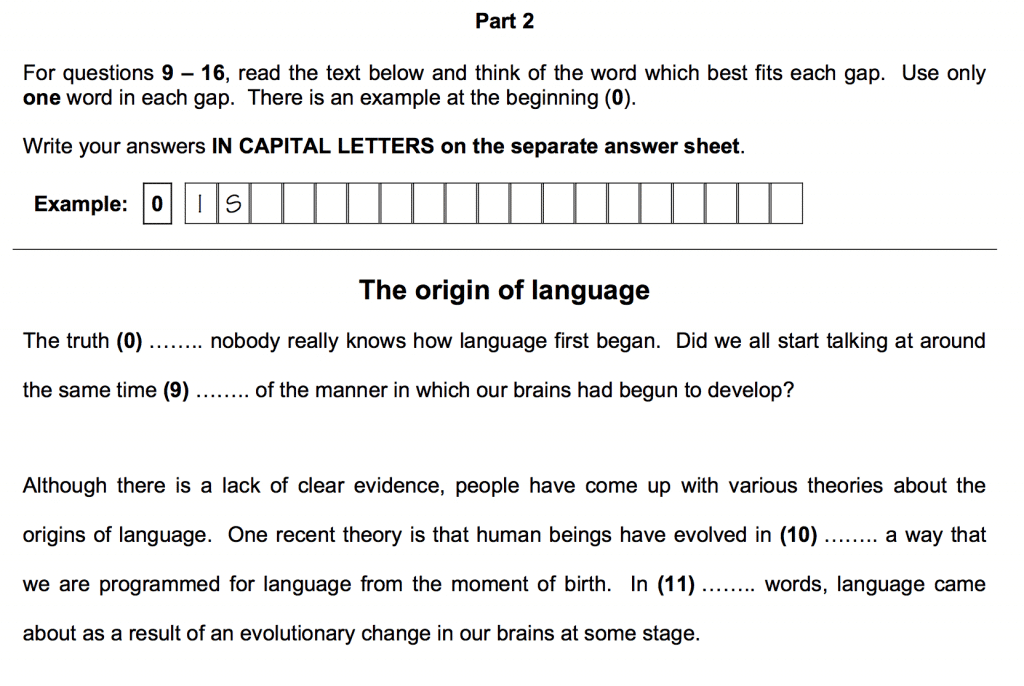CAE Exam Class – Reading and Use of English 2

This CAE Exam Class offers a guide to the second part of the Reading and Use of English Paper in the Cambridge Advanced (C1) Exam, what it tests, how to approach it and how to revise for it.
The second test in the Reading and Use of English Paper of the CAE Exam looks something like this:

(The actual test paper is longer with 8 gaps for you to fill.)
What the test involves
In Part 1, you had to choose the answer from four words given but in Part 2 you get no help at all. You have to think of the word yourself. Don’t worry, while there are hundreds of thousands of words in the English language (nobody can tell you exactly how many), the words you need to find are taken from a relatively small group. They are generally:
- Prepositions
- Pronouns – including relative pronouns
- Articles
- Modal verbs
- Conjunctions
- Adverbs – or one of the words in an adverbial phrase
By the way, do you know what all the above are and can you give some examples? You should be able to – if not look them up online now and remind yourself.
Sometimes the answer will be a verb and often the gerund of the verb. Watch for those prepositions – does the verb follow a preposition? It’s a gerund. The verb ‘to be’ in its various forms is also often an answer.
Time you should spend on this test.
Approximately 10 minutes.
What’s being tested
This is a test of your knowledge of English grammar.
How to do the test
1. Read the title
This will give you a general sense of what the piece is about. Good to know.
2. Skim through the text
Before attempting to choose answers, quickly read through the text to understand what the piece says. This will help you find the answers.
3. Work through the text from the top
The first gap (Numbered ‘0’) is an example. Don’t waste time trying to work out why the answer is correct, but read the sentence and move on to Number 1, then 2 and so on to the end.
Is the answer immediately obvious to you? Put it in. If you are not sure of an answer, but have a good guess, put that in. If you really don’t know, leave it blank and move on to the next. You can come back to these when you’ve done the others and again after you finish other parts of the exam. The point is to not get ‘bogged down’ trying to figure out one answer. Better to use your time getting the ones you can. This is a more efficient use of your time.
4. Go through the text once again
Complete any answers you missed and check the answers that you have already put in. Are you happy with them? Again, if you’re stuck on one answer, don’t get too ‘bogged down’ on one answer. It’s more important to move on to the next part of the exam where there are more points to be scored. You can always come back to this test at the end of the exam if you have time.
Answering the questions
Read through the whole sentence, paying particular attention to the words on either side of the gap and then, if the answer is not obvious to you, try these things…
- What kind of word is needed to fill the gap – a verb, a preposition, a pronoun, a conjunction, an adverb?
- What grammatical structure can you see? Is there a relative clause? Which relative pronoun does it need? Is it a conditional sentence? If so, what word is missing – ‘if’, ‘unless’, ‘would’, ‘could’, or perhaps ‘has’, ‘had’ or ‘have’ to form a perfect or past perfect tense.
- Is the missing word at the start of a sentence or a clause? Is it a pronoun – if so, what does it refer to. Is it plural or singular? Or is it a gerund? Perhaps it is the start of a participle clause? (‘Being’ and ‘Having’ are common answers.) On the other hand, could it be a conjunction?
- Does the gap come in front of a noun and does that noun need an article?
- Does the gap follow a verb; if so, does that verb need a preposition? Which one?
- Read the whole sentence with the word that you think is likely. Does it sound right? Then it probably is.
Scoring
You will get one mark for each correct answer.
Learn to SPEAK English
Join a live online English tutor to get help with your English or study at our school in Dublin, Ireland.
Individual and group classes with our expert teachers.
General English | FCE Exam Preparation | CAE Exam Preparation
CAE Exam Class: An Example of Reading and Use of English Part 2

Let’s have a look at the sample test above.
The first gap (1.) is in a question: “Did we all start talking at around the same time ______ of the manner in which our brains had begun to develop?”
There are two ideas – each represented by a different clause – in this question. The first idea and clause is ‘starting to talk at around the same time’. The second idea and clause is ‘the manner in which are brains had begun to develop’. The missing word joins the clauses together and is followed by the word ‘of’. What types of words join clauses together? Conjunctions and Relative Pronouns. Are relative pronouns followed by ‘of’. No, but some conjunctions are. Which conjunctions do you know that are followed by ‘of’? And does it make sense when placed in the sentence?
The answer is because
The second sentence reads: “One recent theory is that human beings have evolved in ______ a way that we are programmed for language from the moment of birth.”
The gap comes before a noun with an article: ‘a way”. There then follows a clause beginning with ‘that’. The sentence is telling us a about a theory that humans involved in some kind of ‘a way’ and the result of that is ‘we are programmed for language from the moment of birth’. Do you know a determiner which we can put in in front of a noun to describe some kind of that noun, which we can follow with a clause beginning with ‘that’?
The answer is such
The third sentence reads: “In ______ words, language came about as a result of an evolutionary change in our brains at some stage.”
The missing word is between ‘In’ and ‘words’ and then there is a comma! Some kind of expression, by the looks of it – and a way of linking two ideas. Look at the rest of the sentence. It tells us ‘language came about as a result of an evolutionary change in our brains at some stage.” Does this mean the same as the sentence that precedes it? Or something different? It means the same, so we need an (idiomatic) expression which means ‘saying the same thing in a different way’ Do you know it? If not, can you guess it?
The answer is other
What is the best way to revise for this test?
Because this is essentially a test of your knowledge of grammar, you would do well to revise all your grammar notes. Know the parts of speech, defining and non-defining relative clauses, conditionals, passives, adverbial phrases etc. And, as for Part 2 and, in fact, the whole of this paper, familiarise yourself with the language by reading and/or listening to as much good quality English as you can. Choose something you like… books, newspapers, websites about your interests, podcasts, TED talks, whatever… and get stuck in. Look up words or structures you see or hear and don’t know in a good dictionary or online.
More practice
The above sample paper is taken from the official Cambridge English website from where you can download – or complete online – this test and/or an entire practice exam.
You may also be interested in learning about:
CAE Exam Reading and Use of English Part 1
CAE Exam Reading and Use of English Part 3
Happy studying!

This CAE Exam class looks at the third part of the Reading and Use of English Paper in the Cambridge

This CAE Exam class looks at the first part of the Reading and Use of English Paper in the Cambridge

In this CAE Exam class, we’ll look at the first part of the speaking test in the CAE Exam… So,


